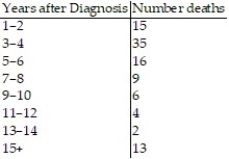A) 40,320
B) 2
C) 8
D) 4
Correct Answer

verified
Correct Answer
verified
True/False
P(E) + P(  ) > 1
) > 1
Correct Answer

verified
Correct Answer
verified
Multiple Choice
A single die is rolled twice. The set of 36 equally likely outcomes is {(1, 1) , (1, 2) , (1, 3) , (1, 4) , 


 (2, 3) , (2, 4) , (2, 5) , (2, 6) , (3, 1) , (3, 2) , (3, 3) , (3, 4) , (3, 5) , (3, 6) , (4, 1) , (4, 2) , (4, 3) ,
(2, 3) , (2, 4) , (2, 5) , (2, 6) , (3, 1) , (3, 2) , (3, 3) , (3, 4) , (3, 5) , (3, 6) , (4, 1) , (4, 2) , (4, 3) , 



 (5, 3) , (5, 4) , (5, 5) , (5, 6) , (6, 1) , (6, 2) , (6, 3) , (6, 4) , (6, 5) , (6, 6) }.
-Find the probability of getting two numbers whose sum is less than 13.
(5, 3) , (5, 4) , (5, 5) , (5, 6) , (6, 1) , (6, 2) , (6, 3) , (6, 4) , (6, 5) , (6, 6) }.
-Find the probability of getting two numbers whose sum is less than 13.
A) 0
B) 1
C) ![]()
D) ![]()
Correct Answer

verified
Correct Answer
verified
Multiple Choice
The table lists the drinking habits of a group of college students. If a student is chosen at random, find the probability of getting someone who is a woman or a heavy drinker. Round your answer to three decimal places. 
A) 0.552
B) 0.830
C) 0.915
D) 0.153
Correct Answer

verified
Correct Answer
verified
Multiple Choice
If P(A) = 0.45, P(B) = 0.25, and P(B|A) = 0.45, are A and B independent?
A) cannot determine
B) no
C) yes
Correct Answer

verified
Correct Answer
verified
Multiple Choice
In how many ways can a committee of three men and four women be formed from a group of 8 men and 8 women?
A) 564,480
B) 560
C) ![]()
D) 3920
Correct Answer

verified
Correct Answer
verified
Multiple Choice
Evaluate the factorial expression.
-
A) 1
B) 489,300
C) 700
D) 699
Correct Answer

verified
Correct Answer
verified
True/False
For two events A and B, suppose P(A) = 0.1, P(B) = 0.8, and P(A|B) = 0.1. Then A and B are independent.
Correct Answer

verified
Correct Answer
verified
True/False
0! = 1!
Correct Answer

verified
Correct Answer
verified
Multiple Choice
Find the indicated probability. If necessary, round to three decimal places.
-Suppose that E and F are two events and that N(E and F) = 440 and N(E) = 710. What is P(  E) =0.9.What is P(E and F) ?
E) =0.9.What is P(E and F) ?
A) 1.614
B) 0.383
C) 0.62
D) 0.062
Correct Answer

verified
Correct Answer
verified
Multiple Choice
Find the value of the combination.
-
A) 5
B) 725,760
C) 3,628,800
D) 10
Correct Answer

verified
Correct Answer
verified
Multiple Choice
A probability experiment is conducted in which the sample space of the experiment is  Let event
Let event  and event B.
and event B.  Assume that each outcome is equally likely. List the outcomes in A or B. Find P(A or B) .
Assume that each outcome is equally likely. List the outcomes in A or B. Find P(A or B) .
A) { 6, 7, 8, 9, 10, 10, 11, 12}; ![]()
B) { 8, 9}; ![]()
C) { 6, 7, 8, 9, 11, 12}; ![]()
D) { 6, 7, 8, 9, 10, 11, 12}; ![]()
Correct Answer

verified
Correct Answer
verified
Multiple Choice
Find the value of the combination.
-
A) 4
B) 12
C) 3
D) 24
Correct Answer

verified
Correct Answer
verified
Multiple Choice
How many arrangement are there of the letters DISAPPOINT?
A) 907,200
B) 1,814,400
C) 3,628,800
D) 1024
Correct Answer

verified
Correct Answer
verified
Multiple Choice
You are dealt one card from a standard 52-card deck. Find the probability of being dealt a picture card.
A) ![]()
B) ![]()
C) ![]()
D) ![]()
Correct Answer

verified
Correct Answer
verified
Multiple Choice
Given that P(A or B) =  , P(A) =
, P(A) =  ,and P(A and B ) =
,and P(A and B ) =  find P(B) . Express the probability as a simplified fraction.
find P(B) . Express the probability as a simplified fraction.
A) ![]()
B) ![]()
C) ![]()
D) ![]()
Correct Answer

verified
Correct Answer
verified
True/False
For two events A and B, suppose P(A) = 0.35, P(B) = 0.65, and P(B|A) = 0.35. Then A and B are independent.
Correct Answer

verified
Correct Answer
verified
Multiple Choice
The table below represents a random sample of the number of deaths per 100 cases for a certain illness over time. If a person infected with this illness is randomly selected from all infected people, find the probability that the person lives 3-4 years after diagnosis. Express your answer as a simplified fraction and as a decimal. 
A) ![]() ; 0.058
; 0.058
B) ![]() ; 0.538
; 0.538
C) ![]() ; 0.35
; 0.35
D) ![]() ; 0.029
; 0.029
Correct Answer

verified
Correct Answer
verified
Multiple Choice
If A, B, C, and D, are the only possible outcomes of an experiment, find the probability of D using the table below.  .
.
A) 2/ 5
B) 3/ 5
C) 1/ 5
D) 1/4
Correct Answer

verified
Correct Answer
verified
Multiple Choice
Find the indicated probability. -At Bill's community college, 39.3% of students are Caucasian and 3.1% of students are Caucasian math majors. What percentage of Caucasian students are math majors?
A) 36.2%
B) 12.7%
C) 7.9%
D) 42.4%
Correct Answer

verified
Correct Answer
verified
Showing 21 - 40 of 91
Related Exams